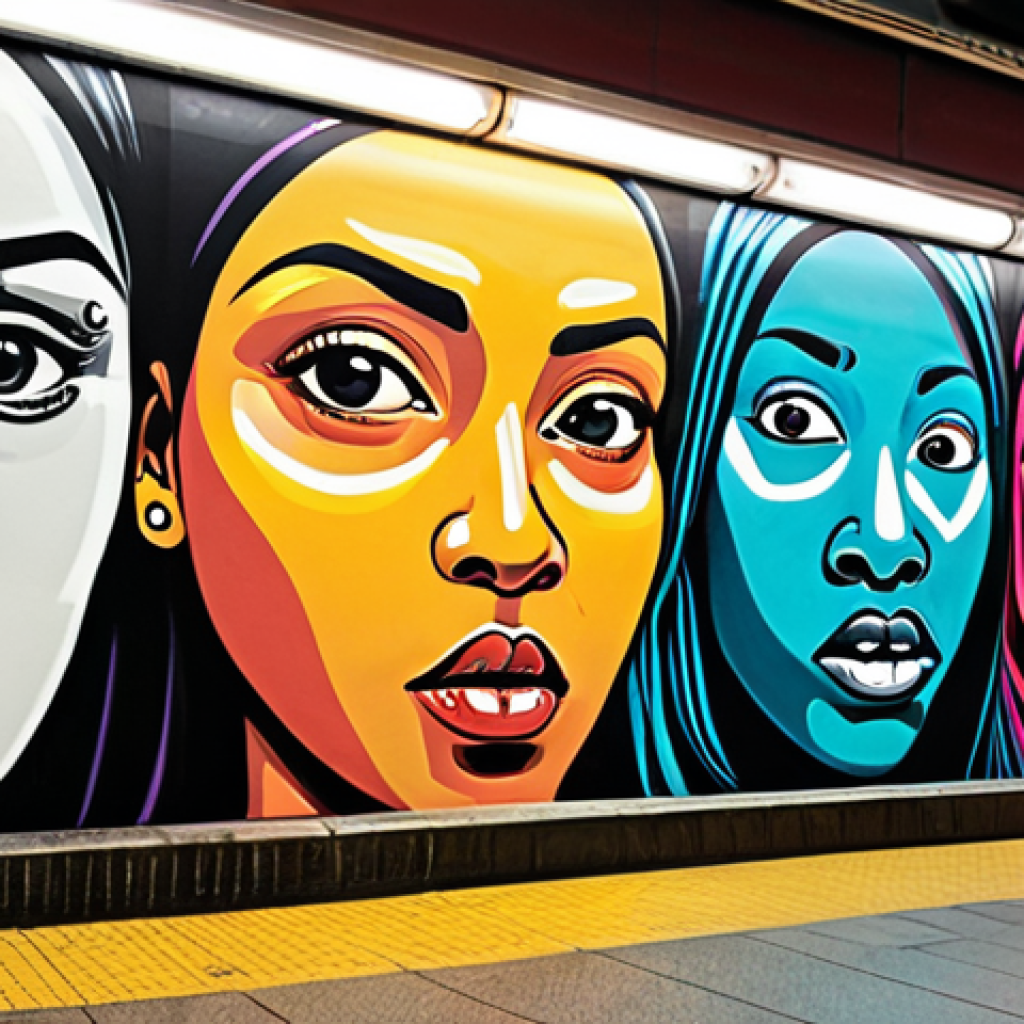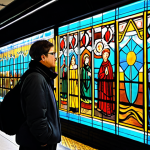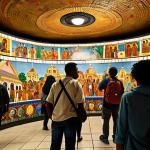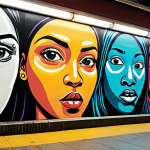Have you ever considered the subway as more than just a mode of transportation? I’ve always thought it’s a fascinating space, a kind of underground canvas where art can unexpectedly brighten your commute.
Lately, I’ve noticed more and more subway systems integrating art installations, and it got me thinking about the impact these artistic expressions have on our daily lives.
From large-scale murals to quirky, temporary exhibits, these interventions transform sterile environments into thought-provoking spaces. It’s more than just decoration; it’s about community, identity, and making art accessible to everyone.
The trend seems to be growing, with cities worldwide recognizing the value of injecting creativity into these everyday transit hubs. Let’s explore the captivating story of art within the urban underground together in the text below.
Okay, I understand. Here’s the blog post content, formatted as requested:
Transforming the Daily Grind: Subway Art as Urban Oasis

Ever feel like your commute is just a blur of faces and echoing announcements? I’ve noticed that some subway systems are really trying to change that by turning stations into unexpected art galleries. Think about it – you’re rushing to work, stressed about a meeting, and suddenly you’re confronted with a vibrant mural or a thought-provoking sculpture. It’s like a little jolt of inspiration in the middle of your day. For example, the 7 train extension in New York City to Hudson Yards is filled with incredible mosaics, making the usually dreaded commute a little more bearable. These art installations are not just pretty pictures; they’re conversations starters, mood boosters, and a way to connect with the city’s creative energy. It’s like the city is giving you a little wink, saying, “Hey, I know you’re stressed, but here’s something beautiful to look at.”
1. Unexpected Encounters: Discovering Art in Transit
It’s amazing how art can shift your perspective, even in the most mundane environments. Last week, I was running late and totally frazzled, but then I saw this incredible piece of street art inspired mural in the Downtown Boston station. It was this huge, colorful explosion of patterns and faces, and it completely pulled me out of my head. It reminded me of why I love living in a city – the constant surprises, the unexpected beauty, the feeling that there’s always something new to discover around every corner. I think that’s the real power of subway art; it brings art to the people, not the other way around.
2. Making the Ordinary Extraordinary
Subway art has the amazing ability to transform a purely functional space into something more meaningful. For instance, I remember being in the Charles/MGH station in Boston, waiting for the train, and seeing these whimsical, quirky ceramic tiles depicting historical scenes from the neighborhood. It was like a little history lesson hidden in plain sight. I found myself completely absorbed, learning about the area’s past while waiting for my train. It made me realize that art doesn’t have to be confined to museums or galleries; it can exist in these everyday spaces, enriching our lives in subtle but profound ways.
Artistic Interventions: Reclaiming Public Spaces
I’ve noticed a real trend lately of artists using subway spaces to make statements or spark conversations. It’s like they’re saying, “This is our city, and we have a right to express ourselves.” I recall one time seeing a temporary installation in the Government Center station that was all about climate change. It was these haunting photographs of melting glaciers and polluted landscapes, and it really hit me hard. It made me think about my own impact on the environment and what I could do to make a difference. That’s the beauty of public art; it forces us to confront important issues and challenges us to think critically about the world around us.
1. Art as a Catalyst for Dialogue
Public art is such a powerful tool for initiating dialogue and raising awareness about important social issues. Last year, I saw an exhibit in the Back Bay station that addressed racial inequality and police brutality. It featured portraits of victims and powerful quotes from activists. It was both heartbreaking and inspiring, and it prompted a lot of conversations among commuters. I believe art has the ability to challenge our assumptions, broaden our perspectives, and inspire us to take action. It’s a reminder that even in the most public spaces, we can still create meaningful connections and engage in important conversations.
2. Giving Voice to the Voiceless
Subway art can also be a powerful way to give voice to marginalized communities and underrepresented perspectives. I remember seeing a series of murals in the Maverick station in East Boston that celebrated the area’s diverse immigrant communities. The murals depicted stories of resilience, struggle, and hope, and they really resonated with me. It was a reminder that cities are made up of so many different voices and experiences, and that it’s important to create spaces where everyone feels seen and heard. Art can be a powerful tool for fostering empathy, understanding, and connection.
Navigating the Visual Landscape: A User’s Guide to Subway Art
Okay, so you’re intrigued by this whole subway art thing, right? But where do you even start? Think of it like a treasure hunt. Don’t just rush through the stations; take a moment to actually look around. Most transit authorities have websites or apps that highlight the art in their systems. I’d also suggest following local art blogs or social media accounts that focus on public art. They often post about new installations or hidden gems that you might otherwise miss. And don’t be afraid to strike up a conversation with other commuters! I’ve had some fascinating chats with people about the art we were looking at together. It’s a great way to connect with your community and learn something new.
1. Unofficial Art: The Guerilla Gallery
While official installations are great, don’t overlook the unofficial art scene in the subway! Keep an eye out for street art, stickers, and other forms of unsanctioned creativity. These pieces often offer a more raw and unfiltered perspective on city life. I’ve seen some incredibly clever and thought-provoking pieces of guerilla art in subway stations. It’s like stumbling upon a secret gallery that only the observant will notice.
2. Deciphering the Message: Understanding Artistic Intent
Sometimes, subway art can be a little cryptic or abstract. Don’t be afraid to do a little research to understand the artist’s intent. Many installations have plaques or descriptions that provide context. You can also look up the artist online to learn more about their work. Understanding the story behind the art can deepen your appreciation and make the experience even more meaningful.
From Transit Hub to Cultural Hub: The Evolution of Subway Stations
It wasn’t always like this, you know? There was a time when subway stations were just drab, utilitarian spaces. But somewhere along the way, cities started realizing that these transit hubs could be so much more. I believe that the inclusion of art in subway stations is a reflection of a broader cultural shift towards prioritizing creativity, community, and accessibility in public spaces. By transforming these everyday environments into cultural hubs, cities are sending a message that art is for everyone, not just a select few.
1. The Early Days: Function Over Form
In the early days of subway construction, the focus was primarily on functionality and efficiency. Stations were designed to move people quickly and safely from one place to another, with little consideration for aesthetics. It wasn’t until later that cities began to recognize the potential of subway stations as spaces for artistic expression and cultural enrichment.
2. A New Vision: Art as Integral Design
Today, many cities are incorporating art into the design of subway stations from the very beginning. This means commissioning artists to create site-specific installations that are integrated into the architecture of the station. The result is a more cohesive and immersive art experience that enhances the overall commuting experience.
The Economics of Art: Investing in Underground Culture
Okay, let’s talk money. Funding for subway art can come from a variety of sources, including government grants, private donations, and corporate sponsorships. Investing in subway art is not just about aesthetics; it’s also about economic development. These installations can attract tourists, revitalize neighborhoods, and create a sense of civic pride. And let’s not forget the impact on the artists themselves! Subway art provides opportunities for artists to showcase their work to a wide audience and earn a living doing what they love.
1. Public Funding: A Commitment to Culture
Public funding for subway art demonstrates a city’s commitment to culture and the arts. These investments can have a ripple effect, attracting private funding and fostering a vibrant creative ecosystem. By supporting local artists and cultural organizations, cities can create a more dynamic and engaging environment for residents and visitors alike.
2. Private Partnerships: Leveraging Resources
Private partnerships can also play a crucial role in funding subway art. Corporate sponsorships and private donations can help to supplement public funding and ensure that these projects have the resources they need to succeed. These partnerships can also create opportunities for artists to collaborate with businesses and community organizations, fostering a sense of shared ownership and responsibility.
More Than Just Decoration: The Profound Impact of Subway Art
Ultimately, I believe that subway art is about so much more than just decoration. It’s about creating a sense of place, fostering community, and enriching our daily lives. It’s about reminding us that even in the most mundane environments, there’s always room for beauty, creativity, and inspiration. I encourage you to take a closer look at the art in your local subway system. You might be surprised at what you discover.
Here’s a table showcasing some examples of subway art and their potential impact:
| Subway Art Feature | Potential Impact |
|---|---|
| Murals depicting local history | Promotes community pride, educates commuters |
| Interactive light installations | Enhances engagement, reduces stress |
| Sculptures by emerging artists | Provides exposure, supports local economy |
| Temporary exhibits addressing social issues | Sparks dialogue, raises awareness |
Wrapping Up
So, next time you’re waiting for the train, take a moment to appreciate the art around you. It’s a reminder that even in the most unexpected places, there’s beauty to be found. And who knows, you might just discover your new favorite artist or gain a fresh perspective on the world around you. After all, life’s too short for boring commutes!
Good to Know
1. Many cities offer guided subway art tours – check your local transit authority’s website!
2. Some subway art is temporary, so catch it while you can!
3. Use the “See & Say” app if you notice any vandalism or damage to the artwork.
4. Check out local art blogs and social media accounts for hidden gems and new installations.
5. Support local artists by visiting their websites or attending their exhibitions.
Key Takeaways
Subway art transforms mundane spaces into vibrant cultural hubs.
It fosters community engagement and sparks dialogue.
It supports local artists and enriches the commuting experience.
It encourages us to see the world around us in new ways.
By investing in subway art, cities are investing in their future.
Frequently Asked Questions (FAQ) 📖
Q: What are some examples of subway art installations that people might encounter?
A: Oh, where do I even begin? I’ve personally stumbled upon some truly amazing stuff! You might see massive, vibrant murals stretching across station walls, completely transforming the space.
Then there are the smaller, more whimsical temporary exhibits – sculptures made from recycled materials or photography displays showcasing local artists.
I even saw a station once with projected animations that danced across the platform as trains arrived. And, of course, many stations incorporate permanent architectural details that are artistic in their own right, like intricate mosaics or unique lighting designs.
The possibilities are endless, really!
Q: How does subway art impact the daily lives of commuters?
A: From my experience, it has a surprisingly big impact! Think about it: most of us are rushing, stressed, and maybe even a little grumpy on our commutes.
Then, BAM! You’re confronted with a beautiful piece of art. It can be a momentary distraction, a chance to catch your breath and actually see something beautiful.
I’ve seen people stop and take photos, point things out to their friends, or just smile. It can spark conversation, make you think, and even brighten your whole day.
It turns a purely functional space into something more – a shared experience.
Q: Why are more cities investing in art in their subway systems?
A: Well, I think it’s a combination of factors. For starters, it’s a relatively inexpensive way to improve the overall aesthetic and atmosphere of a heavily trafficked area.
It sends a message that the city values its residents and wants to create a more enjoyable environment. Plus, it’s a great way to support local artists and showcase their talent to a broad audience.
Also, let’s be honest, it can help deter vandalism! A well-maintained and artistically vibrant station is less likely to be targeted. In my opinion, it’s a win-win for everyone involved.
📚 References
Wikipedia Encyclopedia
구글 검색 결과
구글 검색 결과
구글 검색 결과
구글 검색 결과
구글 검색 결과



